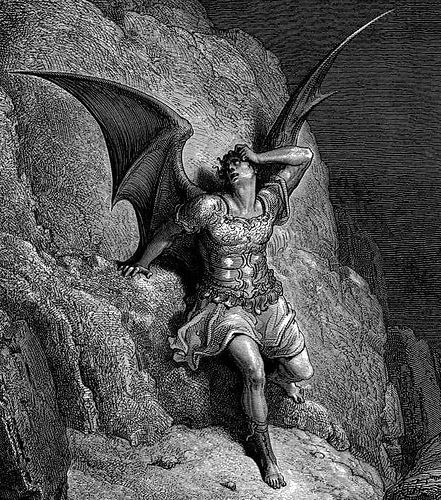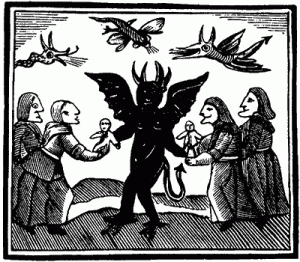 (This post was inspired by the Patheos series “What Do I Really Believe?”. Most of the questions in the series are geared towards Christians, but some of them are still rather interesting)
(This post was inspired by the Patheos series “What Do I Really Believe?”. Most of the questions in the series are geared towards Christians, but some of them are still rather interesting)
If you haven’t read John Beckett’s A Polytheistic Look at the Devil you should take a look at it before proceeding. A lot of what John says I completely agree with (which is usual, no offense to Jason Mankey but Under the Ancient Oaks is my favorite blog on Patheos Pagan), but Modern Paganism’s relationship with “The Devil” is far more complicated than John lets on. While the modern Devil is most certainly a Christian construction, he and his pseudonyms have occasionally made appearances in Modern Paganism.
Growing up I was terrified of the Devil. That fear came from several fronts. The Christian Church I attended sporadically outside of East Peoria Illinois had a very real belief in the Devil. He was an entity there, not a force, and lived to tempt, torment, and ruin. My fear of the Devil also arose independently of Christianity and was tied into the things I was reading in late adolesence. I was interested in the occult and the unexplained at a young age and my local library had a few books on such things, books geared to kids. By age ten I had read about how to sell your soul to the Devil in order to turn into a werewolf along with histories of the Devil as a fallen angel of Yahweh. While reading those kind of things I often felt a heavy presence in the room, as if something was looking over my shoulder. It was a spooky and not a comforting feeling.
Like John, as a polytheist I can’t completely dismiss the idea of the Devil. I’m of the opinion that if billions of people believe in something then that energy of belief goes into manufacturing whatever construct is on their minds. Do I believe in a devil with a pitchfork feeding the furnaces of hell? Certainly not, but I think there’s something that appears every time Satan is invoked. Luckily for us, the people invoking him are almost always Christians. If there’s a negative deity with influence on the world it’s due to the people who keep riling him up.
While Modern Paganism doesn’t have any room for Beelzebub in the circle, there are bits and pieces of our recent past with his hoof marks on them. The character of Lucifer makes an appearance in Charles Leland’s 1899 work Aradia: Gospel of the Witches. It should be noted that Lucifer was originally not a name of the Devil and simply referred to the morning star (Venus). Lucifer can also be interpreted as “light bringer,” and there were groups devoted to that principle in antiquity. Those groups (then and now) never thought of their Lucifer as an Old Testament satan (which basically means obstacle)*, but as a giver of knowledge.
Lucifer shows up at the very beginning of Aradia and seems to straddle the fence between the “cast out” devil figure found in The Book of Enoch and the light bringing morning star:
Diana greatly loved her brother Lucifer, the god of the Sun and of the Moon, the god of Light (Splendor), who was so proud of his beauty, and who for his pride was driven from Paradise.
Diana had by her brother a daughter, to whom they gave the name of Aradia [i.e. Herodias].
At the beginning of the passage Lucifer is a god of light, but the “who for his pride was driven from Paradise” line references the idea of Satan being thrown out of a heaven.
 The idea that Christian names could get attached to pagan religious figures is one of the tenets of Margaret Murray, whose books The Witch-Cult in Western Europe and The God of the Witches argue that “The Devil” of the Medieval (and Renaissance) Witch Trials was an ancient pagan horned god whose worship was corrupted and then driven underground. Murray wasn’t the first writer to suggest such a scenario, the idea first saw print in Jules Michelet’s The Sorcerer which was first published in 1862, with an English edition appearing the following year.
The idea that Christian names could get attached to pagan religious figures is one of the tenets of Margaret Murray, whose books The Witch-Cult in Western Europe and The God of the Witches argue that “The Devil” of the Medieval (and Renaissance) Witch Trials was an ancient pagan horned god whose worship was corrupted and then driven underground. Murray wasn’t the first writer to suggest such a scenario, the idea first saw print in Jules Michelet’s The Sorcerer which was first published in 1862, with an English edition appearing the following year.
 Last Saturday I was talking to a friend about a band we both like that makes occasional references to Satan while also name-checking “the ancient gods” and the “old ways.” There’s a very Pagan-feel to the whole musical enterprise yet the Jack Scratch shout outs had left my friend feeling kind of uncomfortable. When I hear references to the Devil mixed with allusions to Medieval Witchcraft I’m instantly taken back to the ideas of Murray and Michelet, with my friend agreeing that was a good way to look at things.
Last Saturday I was talking to a friend about a band we both like that makes occasional references to Satan while also name-checking “the ancient gods” and the “old ways.” There’s a very Pagan-feel to the whole musical enterprise yet the Jack Scratch shout outs had left my friend feeling kind of uncomfortable. When I hear references to the Devil mixed with allusions to Medieval Witchcraft I’m instantly taken back to the ideas of Murray and Michelet, with my friend agreeing that was a good way to look at things.
In the 20th Century African paganisms were reinterpreted as being linked to the Devil. The idea of “selling your soul at the crossroads to the Devil” is a corruption of the worship of Eshu/Legba, the Yoruban god of the crossroads. The saying that the “gods of the old become the devils of the new” is not too far off the mark. Even when misunderstood it’s a testament to the power of Papa Legba that he still showed up when called upon. (His new forms and names were quite numerous too, sometimes the “black dog” showed up at the crossroads and at other times the “big black man.”)
Don’t get me wrong, Satan isn’t a part of Modern Paganism, but figures and names that can be interpreted as the Christian Devil are a part of our fairly recent past. Saying that Pagans simply “don’t believe in the Devil” is an easy out and doesn’t tell the whole story. Read some Murray and pick up Aradia just in case anyone asks you about the echoes of Old Scratch that occasionally turn up in Contemporary Paganism.
*The Origin of Satan by Elaine Pagels page 47
















